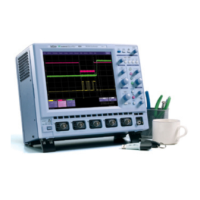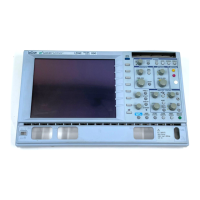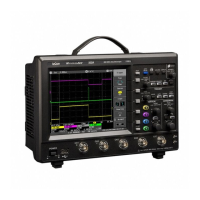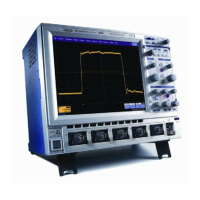8–20
Triggers and When to Use Them
More About Pattern Trigger Once the pattern is defined, one of two transitions can be used to
generate the trigger. When the pattern begins, called entering the
pattern, a trigger can be generated. Alternatively, a trigger can be
generated when the pattern ends, exiting the pattern.
With pattern triggering, as in single source, either of these
qualifications can be selected: Hold-off for 10 ns up to 20 s, or
Hold-off for 1 to 99 999 999 events.
Set to Pattern Trigger, the oscilloscope always checks the logic
AND of the defined input logic states. However, with the help of
de Morgan's laws, the pattern becomes far more generalized.
Consider the important example of the Bi-level or Window Pattern
Trigger. Bi-level implies the expectation of a single-shot signal on
which the amplitude will go in either direction outside a known
range. To set up a Bi-level Pattern trigger, connect the signal to two
inputs: Channels 1 and 2 or any other pair that can be triggered on.
For example, the threshold of CH 1 could be set to +100 mV and
that of CH 2 at −200 mV. The Bi-level Trigger will occur if the
oscilloscope triggers on CH 1 for any pulse greater than +100 mV,
or on CH 2 for any pulse less than –200 mV. For improved
precision, the gains of the two channels should be at the same
setting.
In Boolean notation we can write:
Trigger CH 1 CH 2= + ,
i.e. trigger when entering the pattern CH 1 = high OR CH 2 = low.
By de Morgan's laws this is equivalent to:
Trigger CH 1 CH 2= ⋅ ,
i.e. trigger when exiting the pattern CH 1 = low AND CH 2 = high.
This configuration can be easily programmed.
The possibility of setting the threshold individually for each channel
extends this method so that it becomes a more general Window
Trigger: in order to trigger the input pulse amplitude must lie within
or outside a given arbitrary window.
Pattern Trigger has been designed to allow a choice of the trigger
point. By choosing 1L*2H entering, the trigger will occur at the
moment the pattern 1L*2H becomes true.

